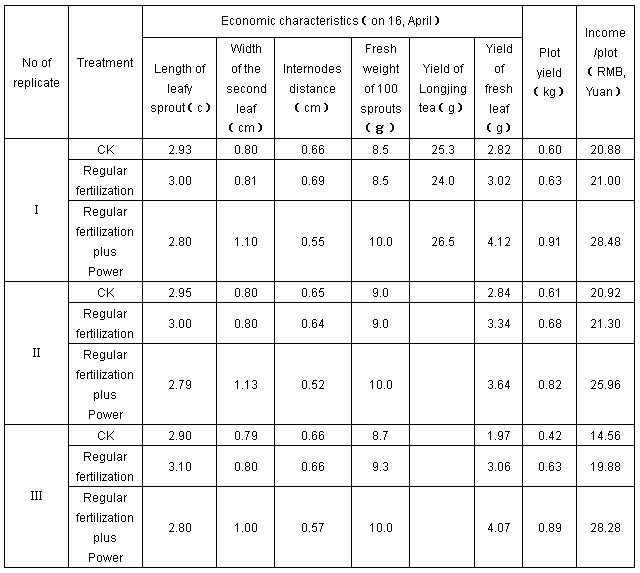Fertilizer
Efficacy Report of Power
Soil and Fertilizer Station of Zhejiang Province
Power
is a fertilizer produced by Dong Yang Lianfeng Biological
Technology Co.£¬Ltd. The efficacy of the product was tested
in tea and foliar vegetable in 1999 according to the requirement
of the manufacturer. The results are presented as below.
1.
Materials and methods
1.1 Experimental site, crop variety
The experimental sites are located in Jinhua City and Zhuji
City, respectively. Crop varieties are Jiukengqunti species
in Jinhua, and Chunanjiukang species in Zhuji, respectively;
The varieties of the vegetable are the representative vegetable
of cabbage in Jinhua, and Hangzhou cabbage in Zhuji.
1.2 Field conditions of the experimental sites
The two experimental sites are the main grain production bases
of Zhejiang Province. They are located in Ningshao plain and
Jinqu basin, respectively. The two sites are both affected
by sub-tropical monsoon moist climate, the average temperature
of the year is mild, and the rainfall is abundant.
The soil in the tea field of Zhuji is red clay developed from
basalt, in cabbage field is muddy soil developed from river
fluxion, and the fertility of the soils is medium. The soil
in the tea field of Jinhua is yellow-red soil and the fertility
of the soils is medium. The soil characteristics are shown
in table 1.
1.3 Experimental design
Treatment 1: CK. In CK plots no any fertilizer was applied
but equal amount of water was sprayed when Power was applied
in plots of treatment 3.
Treatment 2: Regular fertilizer application was conducted
according to the local field management requirement.
Treatment 3: Power was applied on the basis of regular fertilization
management. For tea plants, 2000 time dilute of Power was
sprayed three times before and after the sprouts £»For cabbage£¬1500
time dilute of Power was sprayed three times after transplanted.
Area of the plots: 12m2 forcabbage£¬10m long of tea plants.
Three replicates for each treatment were designed and the
blocks are completely randomized. Guard row was arranged between
treatments.
2.
Results and analysis
2.1 Effect of Power on yield of test plants
Results shown in table 2 indicated that in Zhuji site the
yield of dry tea in Power plots increased by 16.2% compared
with CK (with application of water), by 9.0% compared with
plots with regular fertilization. In Jinhua site the yield
of fresh tea increased 47.4% compared with CK (with application
of water), by 25.6% compared with plots with regular fertilization,
respectively. Also in Jinhua site, the yield of dry tea increased
60.1% compared with CK (with application of water), by 35.1%
compared with plots with regular fertilization, respectively.
In Zhuji site, Power treatment increased yield by 141.7% compared
with CK, and by 4.1% compared with regular fertilization,
respectively.
Variance analysis showed that the yield of tea treated with
Power increased at extremely significance level in Jinhua
site and at significance level in Zhuji site, compared with
CK and regular fertilization. The yield of cabbage treated
with Power in Zhuji site increased at extremely significance
level compared with CK and regular fertilization.
2.2 Effect of Power on the growth and economic characteristics
of test plant
Results presented in table 4 showed that tea plants treated
with Power could produce stronger sprouts, grew shorten node
distance, and produce more qualified tea products. Also Power
treatment could make tea plants sprout earlier and produce
higher yield of tea. In Zhuji the first time of picking tea
could be made on 25th of March, 3 to 5 days earlier than that
in CK. This could increase the market price of tea and increase
tea farmer's income. In Jinhua the average plot income in
Power treated plots was RMB 28.48, higher that that in CK
plots (RMB 20.88/plot) and in regular fertilization plots
(RMB 21.00/plot).
The ratio of input to output for tea was 1£º22¡«27 and for cabbage
was 1£º2.4 (the price was assumed as RMB0.5/kg).
3. Summary
3.1 Application of Power in tea and in cabbage greatly increased
their yield at significance level compared with CK (application
of water) and regular fertilization.
3.2 Application of Power could improve the economic characteristics
of tea plants and increased the produce of advanced quality
tea product. The tea price could be higher due to its earlier
harvest and increase farmer's income.
The ratio of input to output for tea was 1£º22¡«27 and for cabbage
was 1£º2.4(the price was assumed as RMB0.5/kg)
3.3 In order to promote the application of Power fertilizer
in agricultural production we suggested that more experiments
in much more sites should be conducted to find the best application
timing, application rate, and application methods.
June 15,
2000
Table
1 Soil characteristics in experimental sites
Table 2 Effect of Power on yield (Unit£ºkg/mu)
Table 3 Variance analysis of yield increase
Note£ºF0.005(2,6)=5.14£¬F0.001(2,6)=10.9£¬t0.05£¨9£©=2.26¡£
Table
4 Effects of Power on the economic characteristics of tea
plants
Experimental site: Jinhua County

Table 5 Effect of Power on yield of tea at earlier stages
Unit£ºkg, Picking date:25, March
|
